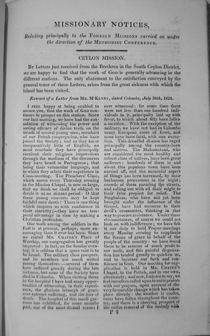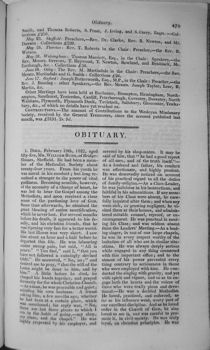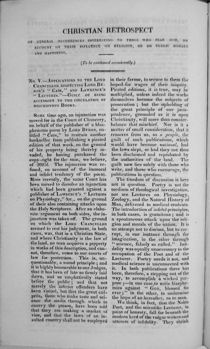|
The Wesleyan-Methodist Magazine, 1778–1969 | |
Sequence |
Third Series, Volumes 1–5 (1822–26) |
Editor |
Jabez Bunting (1821–24; with Thomas Jackson as assistant) |
Publisher |
Thomas Blanshard (1808–23) |
Printer |
Thomas Cordeux (1822–December 1824) |
Price |
1s.; 6d. abridged edn. (1822) |
Format |
Demy 8vo. (in 4s) |
Pages |
72; 36 abridged edn. (1825) |
Frequency |
Monthly |
Circulation |
23,000 (1825) |
Indexes |
All volumes |
Digital |
Digital versions of the Wesleyan-Methodist Magazine, vols 1–123 (1778–1900) are available by subscription via British Periodicals. |
Copies |
Author's
Collection (vol 1 and 4) |
Introduction | |
 The rise to prominence of monthly religious and especially denominational magazines in the first quarter of the nineteenth century was to contemporaries a striking feature of the age. '[E]very little sect among us', complained Thomas Carlyle in 1829, 'Unitarians, Utilitarians, Anabaptists, Phrenologists, must have its Periodical, its monthly or quarterly Magazine;—hanging out, like its windmill, into the popularis aura, to grind meal for the society' (quoted in Topham 2004, p. 70). The Wesleyan-Methodist Magazine was well in the vanguard of this development. Begun in 1778 as the Arminian Magazine, its initial objective in the hands of John Wesley was to counteract the Calvinist theology of the Spiritual and Gospel magazines. From the start, however, it also served to consolidate the Methodist body, inculcating Wesley's principles among those to whom it was distributed through the network of Methodist itinerant preachers, 'societies', and 'classes' which ramified across the country. Continuing in the hands of the Methodist Conference after Wesley's death in 1791, it became the Methodist Magazine in 1798 and the Wesleyan-Methodist Magazine in 1822 (tacitly acknowledging the recent inception of the Primitive Methodist Magazine). Early nineteenth-century commentators were quick to condemn methodists as narrow-minded enthusiasts with little learning or culture. From the start, however, Wesley's magazine ranged far beyond religious topics, including articles on natural history and natural philosophy alongside the theological essays, sermons, biographical sketches, letters, accounts of Christian experiences, and poetry. Wesley was, of course, hardly a standard Methodist, and the editors who succeeded him were neither so cultured nor so liberal. However, the second series of the magazine, begun in 1804, sought to reinstate Wesley's high educational ambitions. The new editor, Joseph Benson (1749–1821), smarting at claims that Methodists were ill-educated fanatics, sought to make the magazine a 'vehicle of useful knowledge and improvement'. It was reorganized into new departments including not only 'Divinity', 'The Word of God Illustrated', 'The Providence of God Asserted', and 'The Grace of God Manifested', but also 'Physico- or Natural Theology' (later 'The Works of God Displayed'), which often provided extensive scientific exposition. Benson also vastly increased the size of the magazine in 1811. It had been a sixpenny magazine of forty-eight pages since its inception, but Benson almost doubled it to eighty pages, issuing it at twice the price, although an abridged sixpenny edition continued to be published alongside the new, expanded version.  Following Benson's death in 1821, the magazine passed into the hands of Jabez Bunting (1779–1858), the powerful figure who contributed heavily to making Methodism a distinct denomination at this period. Bunting had been president of the 1820 Methodist Conference, and stepped in to fill the breach, assisted by another minister, Thomas Jackson (1783–1873). A self-educated farm-labourer's son, Jackson took over the editorship in 1824 but continued to be assisted for a spell by Bunting and a leading Methodist theologian, Richard Watson (1781–1833). Bunting and Jackson, who began a new series in 1822 under the title Wesleyan-Methodist Magazine, carried further not only Benson's formalization of the magazine into sections, but also his determination to give it the stamp of cultured intelligence. Each issue began with a 'Religious Biography'—an account of a deceased minister or 'eminently pious' person, illustrated by an engraved plate (the only illustration in the magazine). There followed 'Divinity', which consisted of sermons and theological essays, 'Miscellaneous Essays, Correspondence, and Extracts', 'Review of Select Theological Publications' and 'Select List of New Books, Chiefly Religious', 'Religious, Philanthropic, and Miscellaneous Intelligence', 'Missionary Intelligence', 'Obituary', and 'Poetry'. While the focus continued to be primarily religious, the discussion was well-informed and intelligent, and many of the articles made reference to scientific topics. Since the magazine was, as Jackson put it, the 'official organ of a large body of religious people, whose every movement' was 'watched by hostile parties', it was edited with a careful eye to Methodist orthodoxy (Jackson 1878, p. 211). The editor was answerable to a management committee consisting of all the London-based ministers and other corresponding members, as well as to the annual Methodist Conference, which could involve itself in the minutiae of editorial practice. Even the advertisements that appeared on the magazines wrappers were carefully scrutinized by a sub-committee. Moreover, while financial inducements were offered to ministers to encourage contributions, no compunction was shown in modifying or rejecting those contributions. Of course, much of the magazine was written by ministers—notably the sermons, biographies, obituaries, and missionary reports (and, one suspects, the anonymous book reviews). However, other readers were invited to contribute and did so, most obviously in the 'Miscellaneous Communications' section; in 1822 Bunting specifically solicited contributions from 'scientific readers' which were 'adapted for popular use' (vol. 1, p. 370).  The magazine's readership was, predictably, largely among members of the Methodist Church. Over ninety percent of the magazines were distributed through its ministers, who received monthly parcels from the Methodist Book Room. There were obvious advantages in this distribution network, both in terms of reducing costs, and in terms of sales. By 1825, the Wesleyan-Methodist Magazine had a circulation of 23,000, making it the most widely circulated religious magazine of the period, roughly on a par with the sixpenny Evangelical Magazine (1793–1904). More importantly, it also made it the most widely circulated periodical for adults of any kind, at least until the inception of the penny periodicals of the 1830s. As Sydney Smith observed of the Wesleyan-Methodist and Evangelical magazines in 1808, their circulation was so 'enormous', and they embodied the opinions and habits 'of so many human beings' that they could not 'but be objects of curiosity and importance' (quoted in Topham 2004, p. 70). The magazine's dominant position declined markedly as the new secular cheap press developed from the 1820s onwards. The religious press also diversified, with religious newspapers such as the Record appearing from the late 1820s, religious penny periodicals such as the Saturday Magazine commencing in the 1830s, and with the introduction of mass-market family weeklies such as the Leisure Hour from the 1850s. Denominational magazines continued to circulate widely (the Wesleyan-Methodist Magazine's circulation in 1860 still stood at 26,000), but they now had to compete with a plethora of other publications. No longer could it be said, as it had been in 1810, that the 'poor' in Methodism read 'little else' than the Methodist Magazine, the Bible and 'Wesley's Books' (quoted in Topham, 2004, p. 70). | |
Notes on Indexing | |
The volumes of the third series of the Wesleyan-Methodist Magazine indexed here represent a sample of the magazine at its greatest influence, but also just on the cusp of the movement for mass-circulation publications that was to change British reading audiences for good. As a result, we see the beginnings in the magazine of a Methodist reaction to the spread of cheap secular publications, including the scientific works of the 'march of mind'. Yet, while the magazine frequently deliberated about the proper means of protecting Methodists, particularly young Methodists, from the insidious dangers of secular learning, it was still confident in its own agenda. Thus, references to the sciences appear across the magazine's content; not just in miscellaneous contributions and reviews, but also in sermons, poetry, obituaries and biographies, and in missionary reports. The indexing here reflects this range, and while some of the shorter articles on specifically scientific topics are adequately characterized with subject and genre classifiers and basic identifications, it is often the more obscure references which are given article descriptions outlining the context and meaning. | |
Bibliography | |
Altholz, Josef L. 1989. The Religious Press in Britain, 1760–1900, New York and London: Greenwood Press. Clement, Mark 1996. 'Sifting Science: Methodism and Natural Knowledge in Britain, 1815–1870', unpublished DPhil thesis, University of Oxford. Cumbers, Frank 1940. The Book Room: The Story of the Methodist Publishing House and Epworth Press, London: Epworth Press. Jackson, Thomas 1878. Recollections of My Own Life and Times, ed. by B. Frankland, London: Wesleyan Conference Office. Jones, Marsh Wilkinson 1995. 'Pulpit, Periodical, and Pen: Joseph Benson and Methodist Influence in the Victorian Prelude', unpublished DPhil thesis, University of Illinois at Urbana-Champaign. Topham, Jonathan R. 2004. 'The Wesleyan-Methodist Magazine and Religious Monthlies in Early Nineteenth-Century Britain', in Reading the Magazine of Nature: Science in the Nineteenth-Century Periodical, by Geoffrey Cantor et al., Cambridge: Cambridge University Press, 67–90. | |
Jonathan R. Topham | |
© Science in the Nineteenth-Century Periodical Project, Universities of Leeds and Sheffield, 2005 - 2020
Printed from Science in the Nineteenth-Century Periodical: An Electronic Index, v. 4.0, The Digital Humanities Institute <http://www.sciper.org> [accessed ]